Greek Pheninda
Antiphanes, a Greek playwright, 388-311BC)
mentions a team game, known as Pheninda (also Episkyros or Sphaeromachia) which
may have been the precursor of the Roman Game Harpastum.
A bas-relief of ancient football is on the base of a marble
column in Athens originating around 600BC. It was depicted on a
4.50 denomination stamp (Sc 1060, SG
1219) issued by Greece as part of the 1972 Olympic Games Issue of the 28th July
1972. The
FDC shows
Greek Athletes. |
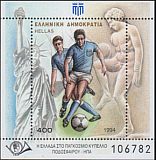 |
|
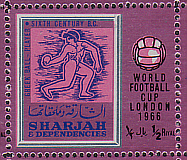 |
The souvenir sheet
above (Sc 1789) was issued by Greece on the 6th June 1994 for the 1994 World Cup
in the USA. The issue included 3 stamps, the
90 denomination stamp (Sc 1787, SG 1950)
included a modern day player along with the ancient carving. The
FDC cachet showed the bas-relief from
the 1972 issue. The stamp at left is one of 7
stamps issued by Sharjah and Dependencies to celebrate the 1966 World Cup. They
were issued in blocks of four both perforate and imperforate. The 1/2r stamp (SG
243) shows a sixth cent BC Greek ball player. |
|
Roman Harpastum
Harpastum, perhaps an offshoot of the Greek Games,
was devised and adapted by the Roman army as a means of keeping shoulders fit.
It appears to be more of a game like rugby rather than soccer. It may have been
introduced into Britain directly when under Roman Rule or during the Norman
Conquests. It may have been a direct ancestor of todays Florentine game of Il
Calcio. |
|
Il Calcio
Florence was founded in the 15th Century. It
forebears went back to Roman days to resurrect the game of Harpastum. The first
recorded game of Il Calcio was played on 10th January 1491 and the first
published rules are in 1555. It may have indirectly influenced British Football
as a game was played in front of the British Consul in 1766. The game was
revived in 1930 and is still played as a tourist attraction today. |
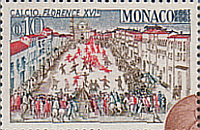 |
|
The stamp at right above (Sc 553, SG 778) and right below (Sc 554, SG 779) was
issued on 12th December 1963 by Monaco in a series "Football through the
Centuries."The Sharjah
1/2r denomination stamp
(SG 246) shows players blowing up a bladder in the 17th Century in the
Italian States prior to a game of Pallo.
|
|
La Soule
La Soule was played in Brittany, Normandy and Picardy. It was
commonly played on Shrove Tuesday, Sundays and Saints Day. It was banned by King
Phillip V, King Charles V and the Bishop of Treguier. It was eventually banned
by the Parliament of Brittany. It persisted into the 20th Century. It may have
influenced British football by contact being made during the Norman Conquests. |
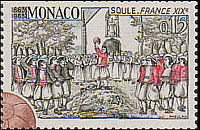 |
|
British Folk
Football
As noted above the origin of Folk Football, often
known as "Mob Football", has variously been described to Roman, Celtic and
Norman influences. In 1314 the Mayor of London issued a proclamation banning
football as it caused such a ruckus in the city. |
|
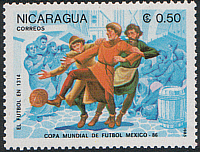 |
On 20th January 1985
Nicaragua issued a set of 7 stamps to celebrate the 1986 World Cup in Mexico.
The 0.50 denomination (Sc 1395, SG 2640) showed football in England at the time
of the London Mayor's proclamation. Another
0.50 denomination stamp
(Sc 1396, SG 2641) showed football in
England in1500. The
1/2r denomination stamp
(SG 245) of the Sharjah issue showed ball games in the 14th Century. |
|
| Attempts
to ban the game due to roughness and damage to property, gave way in the 16th
century to claims that it was "frivolous" and a violation of the peace.
The 1/2r stamp (SG 247) at right shows a game of Football
played at Barnet in Hertfordshire in 1750.
By the nineteenth century changes were occurring in society.
With the industrial revolution, workers had more leisure time and time for
sport. The period in the schools was marked by the doctrine of "muscular
Christianity" and sport was encouraged. |
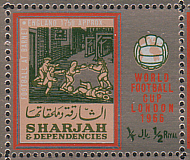 |
|
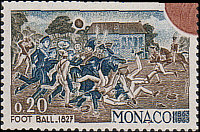 |
As can be seen from
the Monaco Issue (Sc 555, SG 780) the game in a Military Barracks in 1827 was
still a rough and tumble affair with few rules and many injuries.
This was unsustainable as workers were unable to miss time off
work. This led to increasing organisation and codification of the rules of the
games and ultimately Rugby
and Soccer. |
|